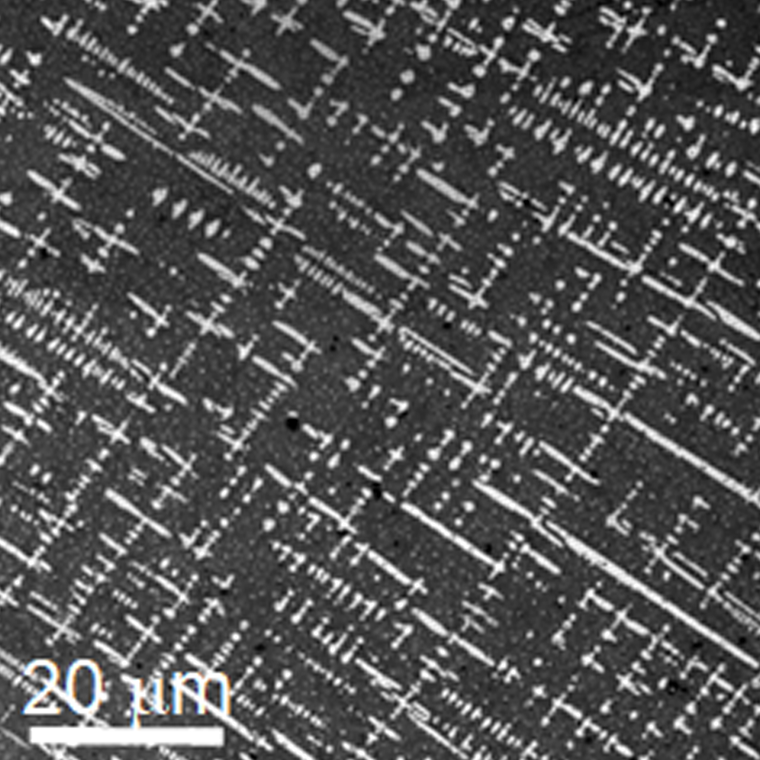Making Cosmic Magnets on Earth
High-performance magnets are the backbone of many vital green technologies, including wind turbines and electric vehicles, but mining for the rare-earth materials at the heart of these machines can have a hefty environmental impact. Researchers have therefore been in search of replacements for rare-earth magnets, with a top contender being tetrataenite—an iron-nickel alloy with a tetragonal crystal structure. Typically, tetrataenite forms in meteorites under an extremely slow cooling process that takes millennia, but a new study has found a way to cast this magnet in a lab in a matter of seconds [1]. The process does not yet result in a practical magnet, but the researchers hope that further work will improve the magnetic properties of these “cosmic magnets” and provide insights into how they form.
Meteorite samples of tetrataenite were first identified in the 1980s. This magnetic material is made from commonly found elements—iron and nickel—arranged in a simple tetragonal structure in which the magnetic moments are biased toward one direction. This so-called uniaxial magnetic anisotropy is a trait required by high-performance magnets. As a result, tetrataenite has captured the attention of researchers looking for alternatives to rare-earth magnets.
The trouble is that the meteorite-based recipe for making tetrataenite requires extremely slow cooling rates (less than 0.01 K per year). Trying to cool the iron-nickel ingredients at a faster rate typically winds up producing a cubic crystal structure rather than the desired tetragonal one. Researchers have managed to make small quantities of tetrataenite in the lab but only under extreme conditions, such as with neutron irradiation. Now Lindsay Greer and Yurii Ivanov at the University of Cambridge and colleagues have found a way to quickly form this metal under nonextreme conditions. The researchers say that the secret hiding under scientists’ noses was an ingredient within tetrataenite-forming meteorites: the element phosphorus.
“It was already known that phosphorus accelerates the diffusion in meteoritic compositions,” Greer says. But no one had yet investigated the effect that phosphorus might have on tetrataenite synthesis in a laboratory setting. “The presence of phosphorus seems to be critical in permitting formation of tetrataenite without such treatments as neutron irradiation,” Ivanov says.
The researchers were not originally trying to make tetrataenite. Instead, their goal was to study the mechanical properties of Fe-Ni-P-B alloys, which typically have a disordered, glass-like microstructure. The team used a conventional casting process in which the alloy ingredients were heated at a temperature of 1123 K and then rapidly cooled. The solidified samples contained a pattern of thin branches called dendrites. Analyzing these features with x-ray diffraction and transmission electron microscopy, the researchers were surprised to find the chemically ordered structure of tetrataenite. By adjusting ratios of elements in their alloy ingredients, the team found that phosphorus was responsible for speeding up the materials’ ordering. The results showed that tetrataenite can form under a cooling rate that is more than 100 billion times faster than the rate in meteorites.
Michael Coey, a magnet expert from Trinity College Dublin, says the process for making tetrataenite is interesting, but he doesn’t think the material meets crucial magnet-energy requirements. “I think the work will influence the direction of research on tetrataenite, as the melt casting method of producing the tetragonal ordered Fe-Ni alloys is new,” Coey says. “But I see no prospect of these alloys replacing rare-earths in any permanent magnet application.”
Greer and Ivanov agree that existing, albeit limited, data on tetrataenite’s magnetic properties suggest that it may not match high-performance neodymium-based magnets. But the researchers maintain that optimization of the tetrataenite casting process could improve its magnetic properties and thus make it a worthwhile option. “It is good to have a wider range of permanent magnet materials, because that allows better balancing of such factors as magnetic performance and environmental impact,” Greer says. “A one-for-one swap with rare-earth magnets is not necessarily the goal.”
For now, the team has demonstrated how to make a piece of tetrataenite, but they say that future work will focus on how to consolidate many pieces into a bulk magnet. “The analogy here would be that we have shown we can make a brick—a piece of tetrataenite—but not yet a house—a magnet,” Greer says.
Beyond materials science, the researchers hint that this work may even impact astrophysics research as scientists reconsider how long it takes for tetrataenite to develop in a meteorite and how fast the cooling rate is in that space environment.
–Sarah Wells
Sarah Wells is an independent science journalist based outside of Washington, DC.
References
- Y. P. Ivanov et al., “Direct formation of hard-magnetic tetrataenite in bulk alloy castings,” Adv. Sci. 2204315 (2022).





